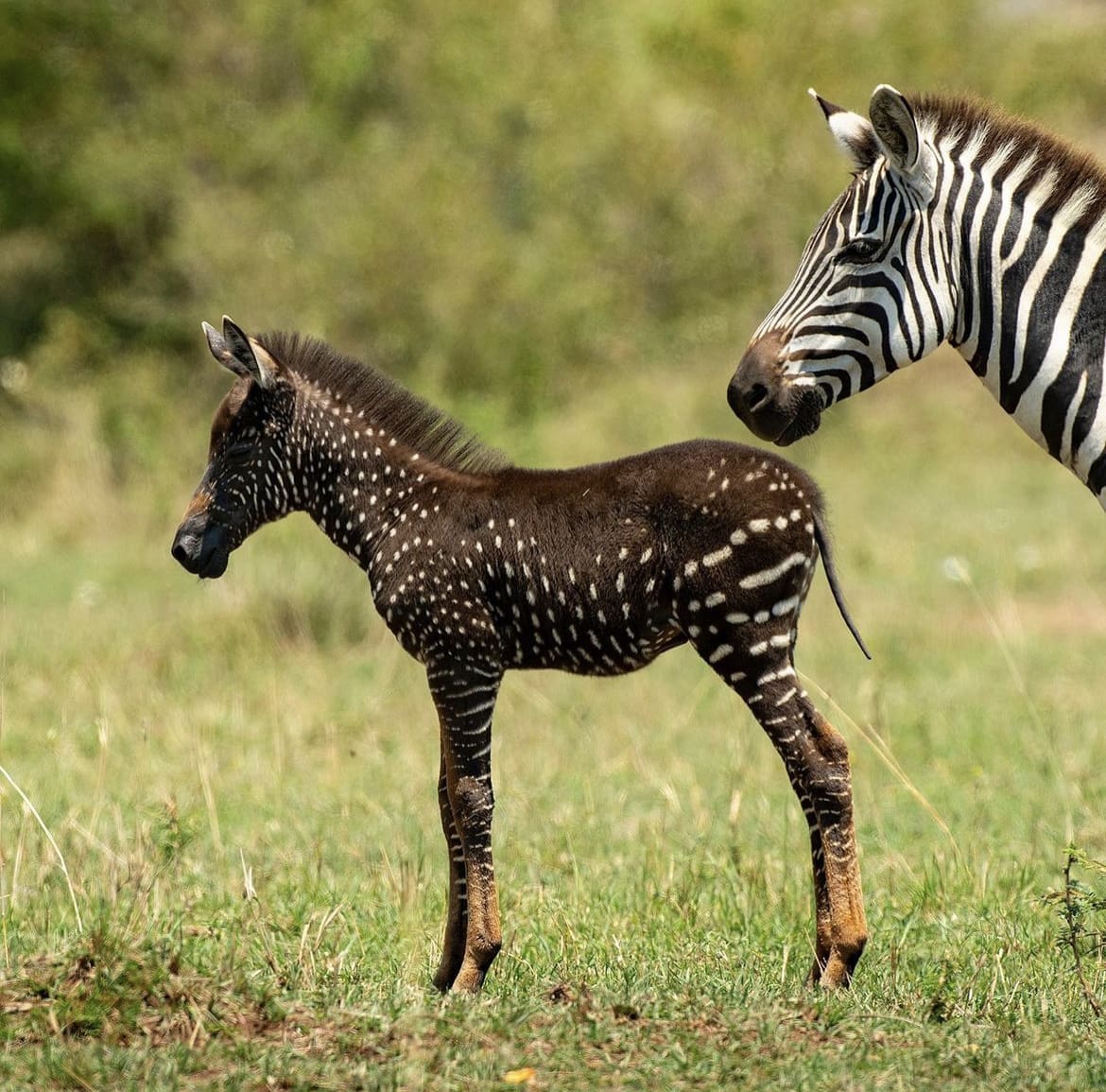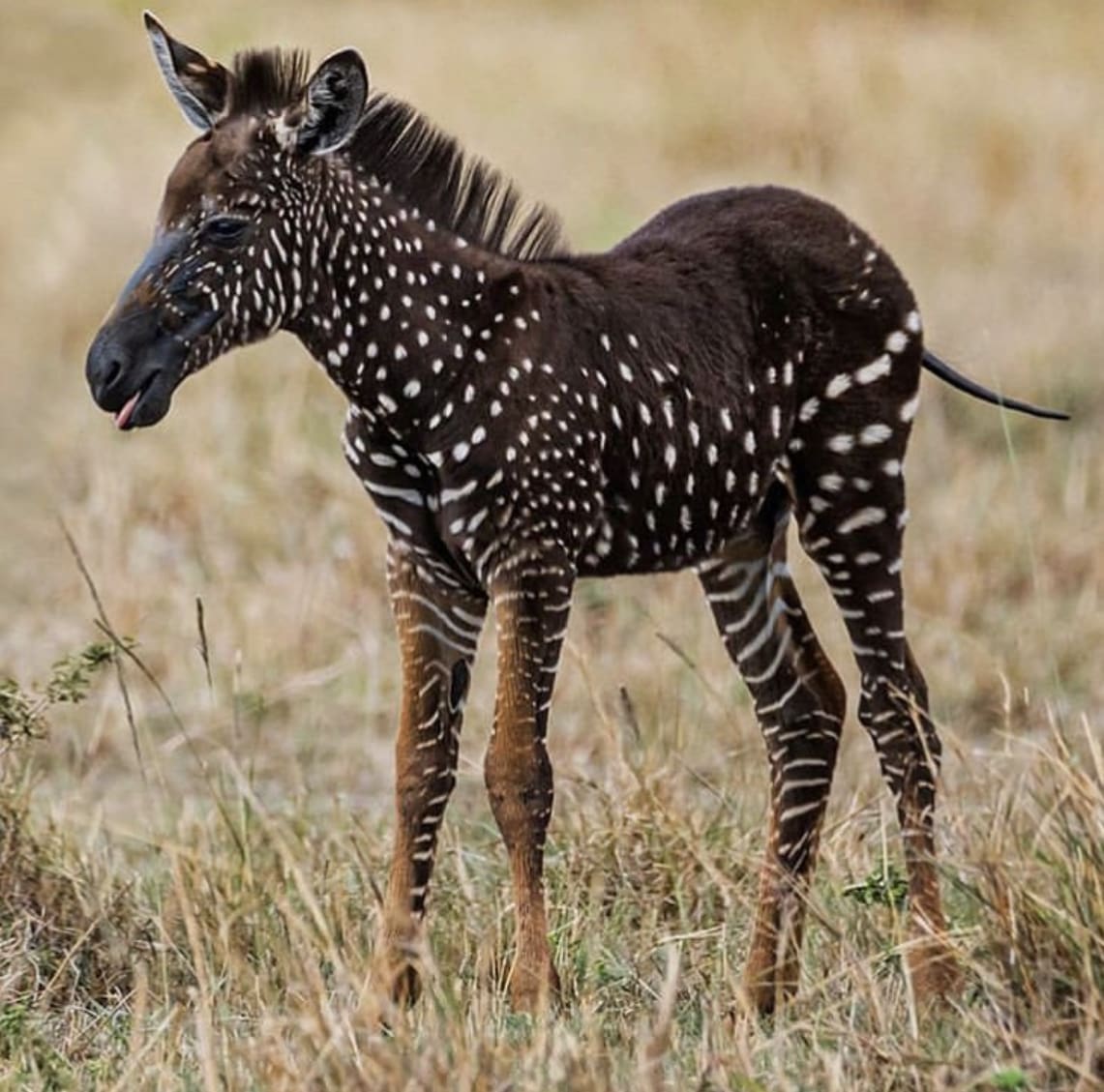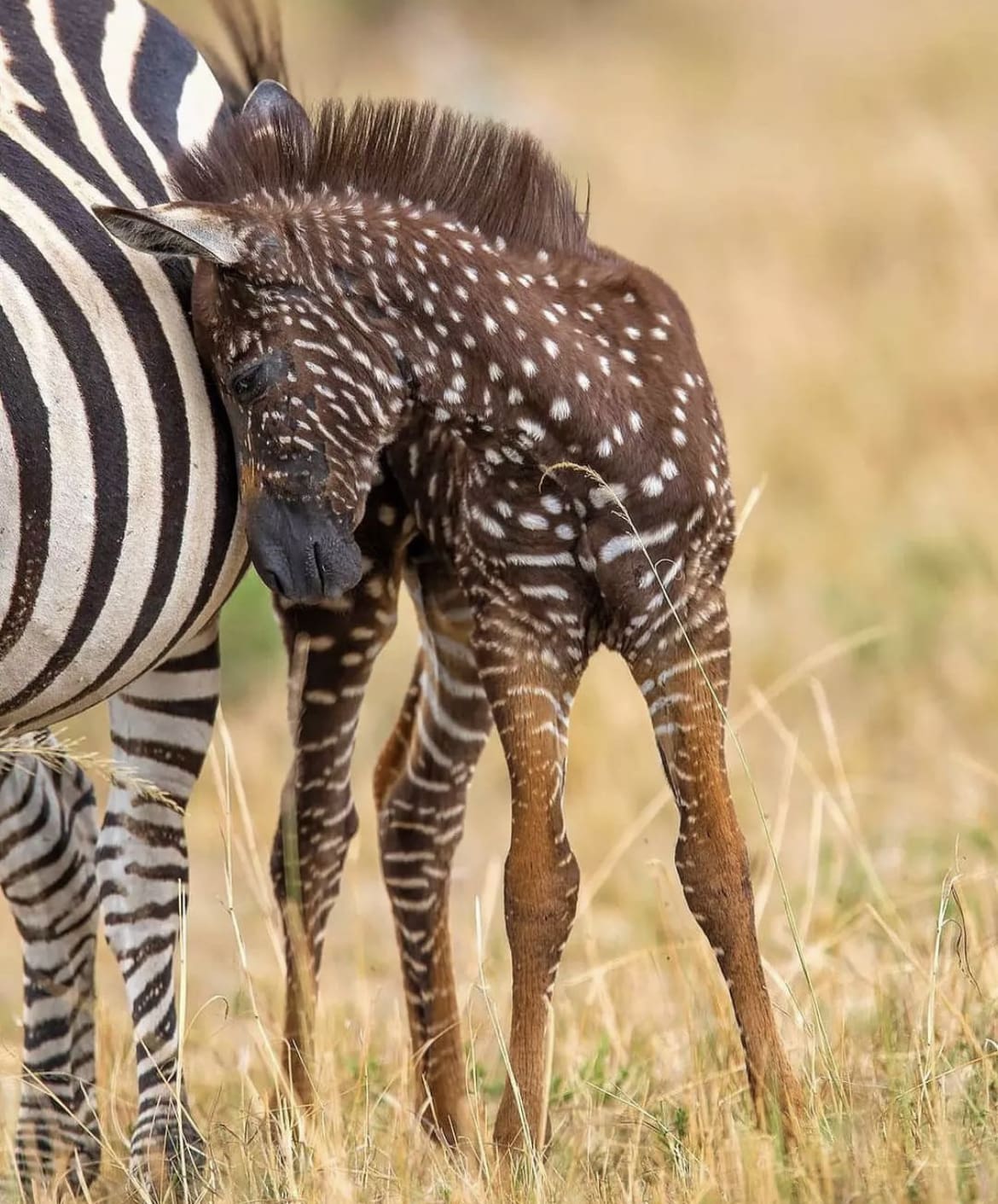[social_warfare]
The Rare, Spotted Zebra Took The World By Storm
Ever heard of a zebra with polka dots? No, this isn’t some wild Photoshop trickery or a new filter on social media. Meet Tira, the zebra that’s rewriting the rules of nature with its one-of-a-kind polka-dotted pattern. Spotted – quite literally – in the Maasai Mara, Kenya’s crown jewel of wildlife havens, Tira isn’t just any zebra; it’s a living, breathing enigma that’s got everyone talking.
The Maasai Mara is no stranger to extraordinary wildlife spectacles. From the thunderous great migration to the raw power plays of the big cats, this place is the epitome of wild. But even in a landscape teeming with life, Tira manages to steal the spotlight. Imagine the surprise of seasoned safari-goers and researchers alike when they first laid eyes on this rare, spotty wonder.
In a world where every zebra looks like a barcode on legs, Tira’s polka-dots are a refreshing twist. This isn’t just a quirky quirk; it’s a fascinating anomaly that has the potential to reveal new insights about zebra genetics and wildlife diversity. So, buckle up as we dive into the story of Tira, explore the science behind those dots, and dish out some insider tips on how you can catch a glimpse of this remarkable creature in the wild.

Who is Tira?
Tira isn’t your everyday zebra; Tira is a trendsetter in the animal kingdom. Spotted – quite literally – on the sprawling plains of the Maasai Mara, Tira’s unique polka-dotted coat has made it a celebrity among wildlife enthusiasts. But who exactly is Tira, and how did this speckled superstar come to be?
Tira was first discovered by a Maasai tour guide, who named the zebra after his surname. When word got out about a polka-dotted zebra, it spread faster than a wildfire in the savannah. Tourists, researchers, and photographers flocked to the Mara, hoping to catch a glimpse of this extraordinary animal.
Unlike the typical zebra’s black-and-white stripe pattern, Tira sports a series of irregular, polka-dot-like spots. This pattern isn’t just unusual – it’s incredibly rare. Zebras, as we know, are defined by their stripes, each pattern as unique as a human fingerprint. But Tira’s spots? They’re in a league of their own, making this zebra an instant icon.
So, what’s the story behind those spots? It all comes down to genetics. Zebras have complex stripe patterns influenced by a variety of genetic factors. Tira’s polka-dots are likely the result of a genetic mutation, something that makes this zebra even more special. This kind of mutation is a natural reminder of the incredible diversity of life on our planet.
Tira’s unique appearance isn’t just a visual delight; it’s a gateway to understanding more about zebra genetics and how these beautiful creatures adapt to their environments. It sparks curiosity and wonder, encouraging us to delve deeper into the mysteries of nature.

The Science Behind the Spots
Zebras are typically known for their striking black-and-white stripes, a pattern that serves as both camouflage and a social signal among the herd. Each zebra’s stripe pattern is unique, much like human fingerprints, providing individual identity in the vast savannah. However, Tira’s polka-dotted pattern is a fascinating departure from the norm.
Tira’s spots are the result of a genetic mutation, a naturally occurring phenomenon that can sometimes lead to unique and unexpected traits. This specific mutation likely affects the way melanin, the pigment responsible for coloration in animals, is distributed during Tira’s development. Instead of forming the usual striped pattern, Tira’s melanin cells clumped together in spots, creating a look that’s more akin to polka dots than stripes.
This genetic anomaly is known as pseudomelanism, a condition where the typical stripe pattern of a zebra is altered, resulting in a variety of unique markings. While pseudomelanism is rare, it’s not entirely unheard of in zebras. However, Tira’s pattern is particularly distinctive and has captivated the attention of both scientists and the public alike.
Comparing Tira’s dots to the traditional stripes of zebras reveals just how unique this pattern is. Stripes serve several purposes for zebras: they help with camouflage by breaking up the outline of the body, confuse predators, and even play a role in social interactions within the herd. Tira’s spots, on the other hand, challenge our understanding of these functions. Scientists are keen to study whether Tira’s unique pattern offers any distinct advantages or disadvantages in the wild.
The curiosity sparked by Tira’s appearance goes beyond just visual appeal. It opens up questions about how such mutations occur and their implications for the species. Could Tira’s spots be a one-off anomaly, or do they hint at a broader spectrum of genetic diversity within zebra populations? These questions make Tira not just a marvel to look at but also a valuable subject for scientific research.

The Maasai Mara – Tira’s Home
If you’re planning to catch a glimpse of Tira and her fellow zebras, there’s no better place to start than this stunning African landscape.
The Maasai Mara, located in southwestern Kenya, is a vast expanse of rolling grasslands, acacia trees, and riverine forests. It’s a haven for wildlife, boasting one of the highest concentrations of large mammals in the world. From the thunderous migration of wildebeests to the stealthy prowls of big cats, the Mara is a living, breathing tapestry of life that offers something new and exciting at every turn.
Tira has made a splash in this vibrant ecosystem, but the Maasai Mara itself is worth the trip. This reserve is part of the larger Serengeti-Mara ecosystem, which spans across the Kenya-Tanzania border. It’s renowned for the Great Migration, where millions of wildebeests, zebras, and other herbivores journey in a circular route in search of fresh grazing. This spectacle, often referred to as “The World Cup of Wildlife,” is one of nature’s most dramatic events.
But beyond the migration, the Maasai Mara is home to a diverse range of wildlife. Lions, cheetahs, elephants, and giraffes roam the plains, while hippos and crocodiles lurk in the Mara River. Bird enthusiasts will be thrilled by the sight of over 450 bird species, from colorful lilac-breasted rollers to majestic raptors.
Travel Tips for Visiting the Maasai Mara:
- Best Times to Visit: While the Maasai Mara is a year-round destination, the best time to visit is during the dry season, from June to October. This period coincides with the Great Migration, offering spectacular wildlife viewing opportunities.
- Getting There: The Maasai Mara is accessible via several airstrips serviced by local airlines, with flights departing from Nairobi. Alternatively, you can embark on a road trip from Nairobi, which takes about 5-6 hours, giving you a chance to soak in the scenic Kenyan countryside.
- Where to Stay: Accommodations in the Maasai Mara range from luxury lodges to tented camps. Whether you prefer a plush safari lodge or an authentic tented camp experience, there’s something to suit every taste and budget.
- What to Pack: Bring lightweight clothing, a good pair of binoculars, a camera with a zoom lens, and plenty of sunscreen. Don’t forget your sense of adventure!
One of the magical aspects of the Maasai Mara is its ability to surprise and delight. You might set out on a game drive with the goal of seeing Tira, only to find yourself captivated by a lioness and her cubs, a towering giraffe nibbling on acacia leaves, or a herd of elephants making their way to the river. Each moment in the Mara is a reminder of the rich and intricate web of life that thrives in this extraordinary landscape.
For those eager to spot Tira, the best strategy is to join a guided safari tour. Experienced guides know the terrain intimately and can increase your chances of encountering not only Tira but also other remarkable wildlife. And remember, the joy of a safari lies in the unexpected – sometimes the most memorable encounters are the ones you least anticipate.

Conservation Efforts
The magic of the Maasai Mara and the wonder of seeing a polka-dotted zebra like Tira come with a crucial responsibility: conservation. Protecting the incredible diversity of wildlife in Kenya is essential, not just for preserving the unique spectacle of Tira but for maintaining the entire ecosystem’s health and balance.
The Maasai Mara is more than just a playground for safari-goers; it’s a vital sanctuary for countless species. The delicate balance of this ecosystem hinges on careful conservation efforts. From the sprawling savannahs to the meandering rivers, every part of the Mara plays a role in sustaining the wildlife that calls it home.
Tira’s unusual appearance has done more than just capture the attention of tourists and wildlife enthusiasts; it has shone a spotlight on the importance of genetic diversity and conservation. Animals like Tira help raise awareness about the need to protect wildlife habitats and the species that depend on them.
Wildlife conservation in the Maasai Mara faces numerous challenges, from habitat loss due to agricultural expansion to human-wildlife conflict and the threat of poaching. To combat these issues, various organizations and local communities are working tirelessly to ensure that the Mara remains a safe haven for its inhabitants.
Key Conservation Efforts in the Maasai Mara:
- Anti-Poaching Initiatives: Poaching remains a significant threat to wildlife in Kenya. Anti-poaching units, often working in collaboration with local communities and international organizations, patrol the reserve to protect animals from illegal hunting. These efforts are crucial in safeguarding species like elephants, rhinos, and even zebras.
- Community-Based Conservation: Local communities play a vital role in conservation. Many conservation programs involve the Maasai people, who have lived in harmony with the wildlife for generations. By integrating traditional knowledge and practices with modern conservation techniques, these programs promote sustainable coexistence.
- Habitat Restoration: Protecting and restoring habitats is essential for maintaining biodiversity. Efforts to reforest areas, protect water sources, and manage grasslands help ensure that wildlife has the resources it needs to thrive.
- Research and Monitoring: Continuous research and monitoring are vital for understanding the dynamics of the ecosystem and the needs of its inhabitants. Studies on animal behavior, genetics, and environmental changes provide valuable data that informs conservation strategies.
- Eco-Tourism: Sustainable tourism practices are key to conservation. By promoting eco-tourism, the Maasai Mara generates revenue that supports conservation efforts while minimizing the environmental impact. Responsible tourism ensures that future generations can enjoy the wonders of the Mara.
Tira’s unique appearance has brought a renewed focus on the importance of protecting genetic diversity. Genetic variations, like Tira’s polka-dots, are essential for the resilience and adaptability of species. They help populations survive changes in their environment and can even lead to the emergence of new traits that may offer survival advantages.
Seeing Tira in the wild is a powerful reminder of the beauty and fragility of our natural world. It underscores the need for continued conservation efforts to protect not only the iconic animals of the Maasai Mara but also the entire ecosystem they depend on.

Practical Tips for Safari Goers
So, you’re pumped and ready to see Tira, the polka-dotted zebra, in the wild. But before you jet off on this once-in-a-lifetime adventure, let’s arm you with some practical tips to make your safari experience as epic as possible.
Safari Tips for Spotting Tira and Other Wildlife:
- Join a Guided Safari Tour: Your best bet for seeing Tira and other wildlife is to go with a knowledgeable guide. Local guides have the inside scoop on the best spots and times to catch a glimpse of the animals. They know the terrain like the back of their hand and can increase your chances of a successful sighting.
- Optimal Viewing Times: Wildlife is most active during the early morning and late afternoon. These cooler parts of the day are prime times for game drives. Plus, the lighting is perfect for those Instagram-worthy shots!
- Be Patient and Observant: The beauty of a safari lies in the unexpected. Keep your eyes peeled, and be patient. Sometimes, the most extraordinary moments happen when you least expect them.
- Stay Silent and Respectful: Animals are more likely to approach if they don’t feel threatened. Keep noise to a minimum and respect the wildlife by maintaining a safe distance.
Packing Essentials for Your Safari:
- Clothing: Light, breathable clothing is key. Opt for neutral colors like khaki, beige, and olive to blend in with the environment. Don’t forget a wide-brimmed hat and sunglasses to protect yourself from the sun.
- Footwear: Comfortable, sturdy shoes are a must. You’ll be doing a fair bit of walking, so make sure your footwear is up to the task.
- Binoculars: A good pair of binoculars can make all the difference. Spotting wildlife at a distance is much easier with a quality pair.
- Camera Gear: Bring a camera with a zoom lens to capture those stunning close-ups. Extra memory cards and batteries are also essential – you don’t want to miss a single shot.
- Sun Protection: Sunscreen, lip balm, and insect repellent are crucial. The African sun can be harsh, and bugs are plentiful.
- Hydration and Snacks: Staying hydrated is vital, especially in the heat. Pack a reusable water bottle and some snacks to keep your energy up.

As your journey through the captivating world of the Maasai Mara comes to a close, it’s time to reflect on the unique charm of Tira and the broader significance of such encounters. Zebras are often seen as the quintessential symbols of the African plains, but Tira’s polka-dots add a whole new layer of wonder to these iconic creatures. Beyond the visual spectacle, Tira’s story is a reminder of the diversity and adaptability of wildlife – traits that are worth celebrating and protecting.
The first time you see Tira, it’s impossible not to be struck by the beauty of nature’s randomness. There’s something incredibly special about witnessing a creature that defies expectations. Tira’s spots aren’t just a genetic fluke; they’re a testament to the endless variations that nature can produce. It’s this unpredictability that makes wildlife watching so thrilling.
One of the most memorable moments on safari might be seeing Tira grazing peacefully, seemingly unaware of the stir caused by those unique spots. It’s a humbling experience, reminding us of the importance of protecting these natural wonders.
The Maasai Mara is teeming with life, and there’s no shortage of unique animals and experiences to discover. Here are a few recommendations to enhance your safari adventure:
- The Big Five: While Tira is a standout, don’t miss the opportunity to see the Big Five – lions, leopards, rhinoceroses, elephants, and Cape buffaloes. Each encounter with these majestic animals offers its own dose of excitement and awe.
- The Great Migration: If your timing aligns, witnessing the Great Migration is an experience like no other. The sheer volume of animals moving across the plains is a sight to behold and a highlight of any safari.
- Balloon Safari: For a different perspective, consider a hot air balloon safari. Floating over the Mara at dawn, you’ll get a bird’s-eye view of the landscape and its inhabitants, providing a unique and serene experience.
- Cultural Encounters: Engage with the local Maasai communities. Their rich culture and traditions add depth to your understanding of the region. Many lodges offer visits to Maasai villages where you can learn about their way of life and how they coexist with wildlife.
- Night Safaris: Experience the Mara after dark on a night safari. This is your chance to see nocturnal animals in action, adding another layer of excitement to your adventure.
